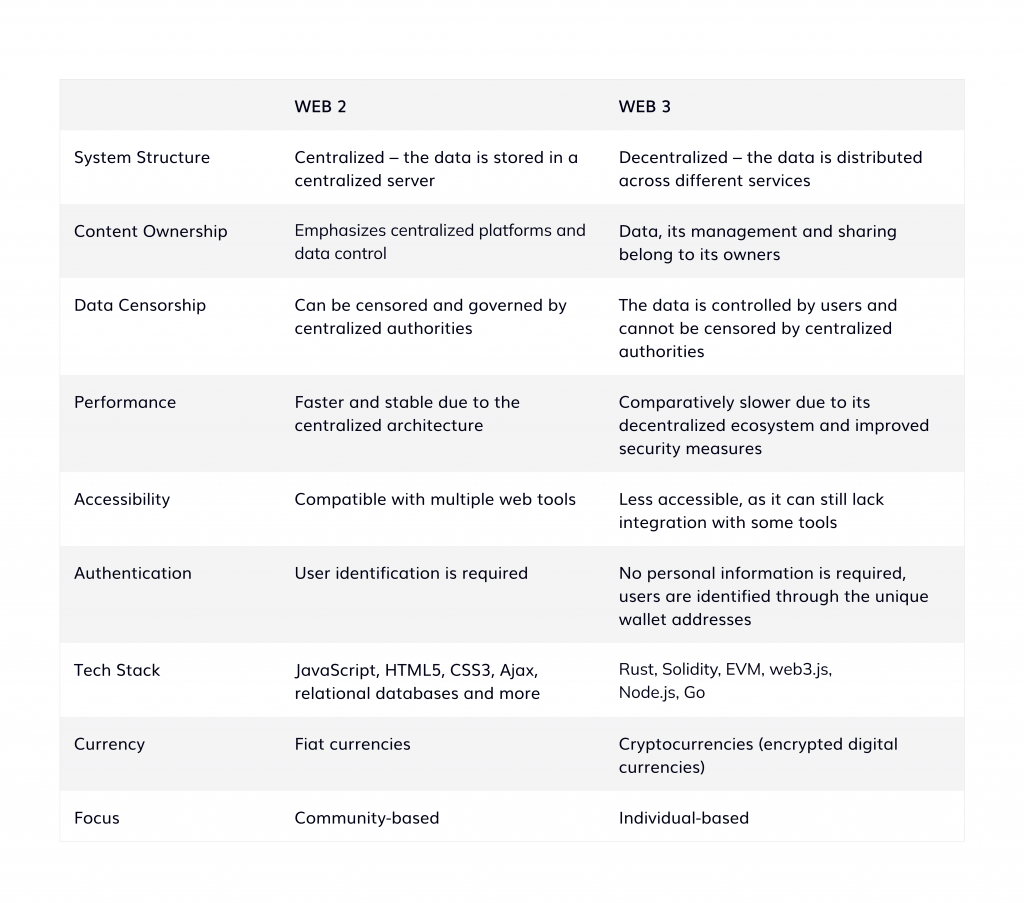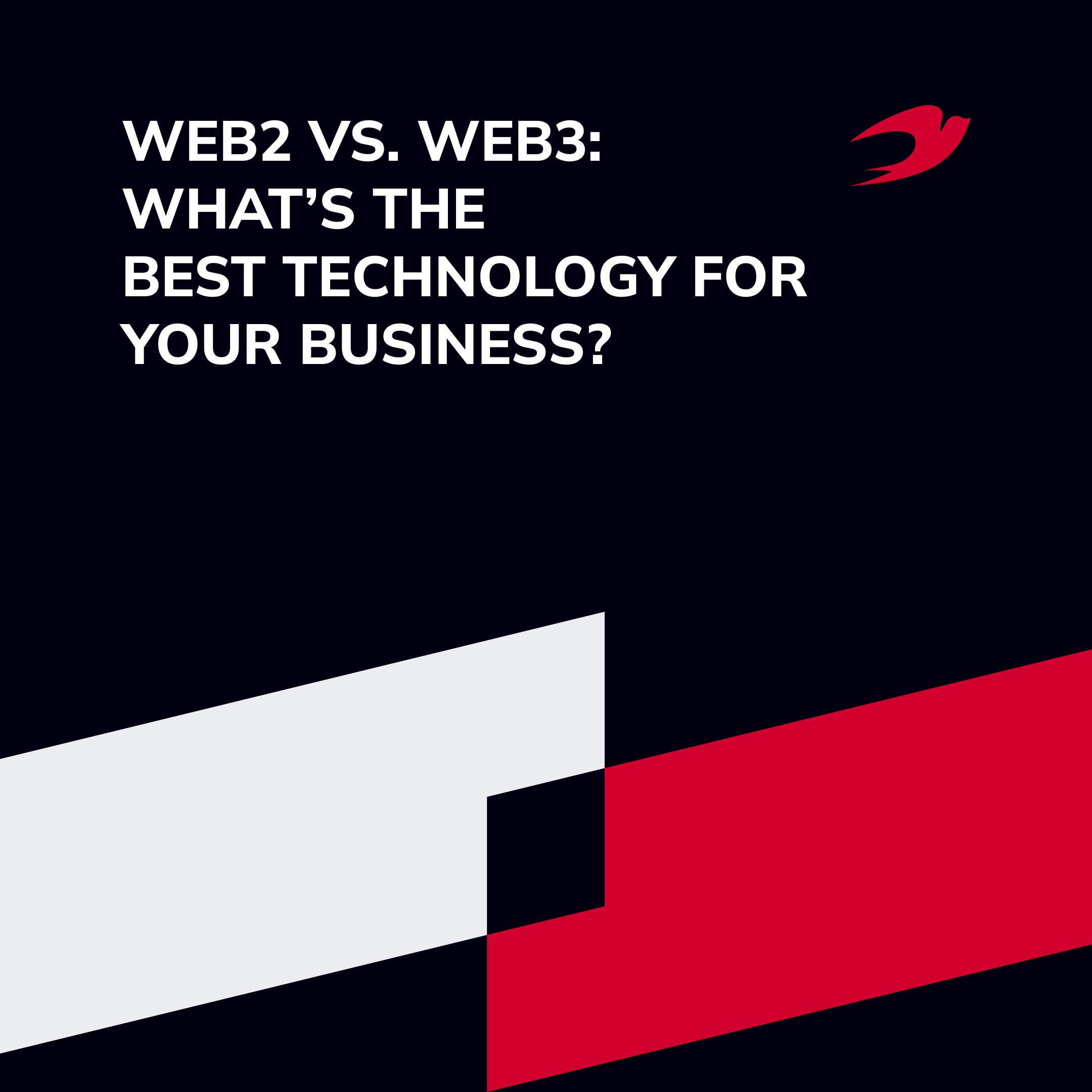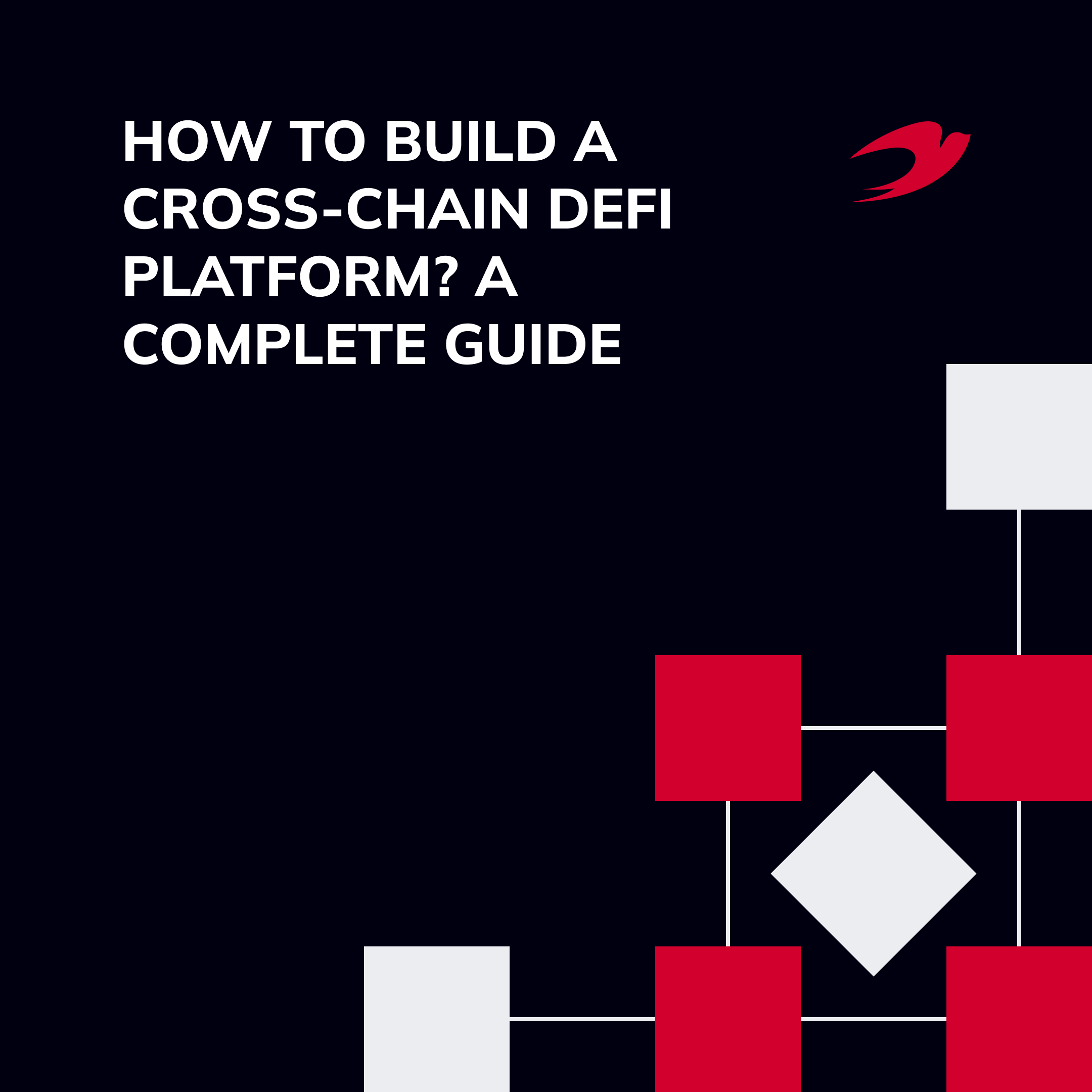So far, we’ve witnessed huge progress in the evolution of web technologies, which currently evolved into three generations: Web 1.0, Web 2.0 and Web 3.0. And, while there’s a minor gap between the first and second gen, the difference between Web 2.0 and Web 3.0 is more notable.
In this post, our dedicated developers from IdeaSoft will shed light on Web 2.0 and Web 3.0 architecture, explaining the specifics, advantages and use cases of each. Additionally, we’ll explore what projects need the Web 3.0 migration and its potential benefits for SMBs and large enterprises.
Table of content:
- Web 2.0: Key Features & Examples
- Web 3.0: Main Principals & Use Cases
- What’s the Difference Between Web 2.0 and Web 3.0 Architecture?
- Pros & Cons of AI for Web 2.0 and Web 3.0 Apps
- Web 2.0 vs. Web 3.0: Which Apps Should Migrate?
- Products That Will Never Make It to Web 3.0
- The Future Potential of Web 2.0 and Web 3.0
- Summary
Web 2.0: Key Features & Examples
To help you study deeper the differences between Web 2.0 and Web 3.0 development, let’s make an in-depth overview of each technology. This will help you to get a better idea on which one will be a better match for your project and meets all your business objectives and needs.
With over two decades of presence, Web 2.0 has got a wide range of appliances and not without a reason. Some of the most notable features of this technology that are still relevant include:
- Centralized architecture;
- Transparency in data and integrations;
- Application Programming Interfaces (APIs);
- Web as a platform, not just a network;
- Enhanced functionality and user interactions, more opportunities for collaboration;
- Plenty of customization options;
- Improved audience connection and marketing capabilities.
Such a large set of advantages of Web 2.0 has made it the top choice for millions of projects in social networking, content sharing and streaming, eCommerce and online marketplaces, financial and banking, eLearning and online education, cloud computing and so much more.
Today, Web 2.0 technology has been used by companies of different scales and niches. From progressive software for businesses like Microsoft or Adobe Creative Cloud to web-based user-oriented products like Zoom, Netflix, Twitter or Instagram – the Web 2.0 architecture has become a solid “backbone” of those all.
Web 3.0: Main Principals & Use Cases
Web 3.0, on the contrary, is known as a decentralized digital network solution, which is powered by blockchain. Though the technologies in Web 3.0 are almost identical to the previous gen, its architecture is built using the decentralized blockchain. Some other important features of this network include:
- Blockchain;
- Distributed Ledger Technology (DLT);
- Smart сontract technology;
- Tokenization;
- Trustless and permission-less controls and environments;
- Enhanced cross-chain interoperability;
- Improved security and privacy;
- Solid governance mechanisms.
The underlying concept of Web 3.0 is aimed to make internet searches more simple, efficient and in no time. The reduced reliance on centralized authorities results in improved trustability and transparency, which in combination with blockchain can uncover new possibilities for innovation, collaboration and growth.
Today, the Web 3.0 application is a popular tech solution for decentralized protocols and DEX platforms, metaverse solutions, AI and ML-powered apps, NFT marketplaces, decentralized social networks and so much more.
But does that mean that Web 3.0 is better than Web 2.0? Not quite. A majority of web experts expect Web 3.0 to develop along with the second generation, providing a wide range of decentralized optimizations for businesses.
What’s the Difference Between Web 2.0 and Web 3.0 Architecture?
As we mentioned, most Web 3.0 capabilities are already present in Web 3.0. So, should you actually choose Web 3.0 or Web 2.0?
Below we’ve reviewed the architecture and infrastructure of both to help you find the best option for your business needs.

So, as you compare the Web 2.0 to Web 3.0 specifications, you can explore the major differences in data ownership and management, user accessibility and authentication, technologies and its social focus.
Thinking of migrating your Web 2.0 solution?
Let us help you figure it out, and correctly draw up the requirements for your project!
Pros & Cons of AI for Web 2.0 and Web 3.0 Apps
AI integrations is among the hottest topics of discussion in the tech world, and the network niche is not an exception. Recently, we’ve discussed the integration of AI and machine learning for mobile app development, and here we’ve analyzed the key gains and drawbacks of AI for Web 2.0 and Web 3.0 solutions.
What Are the Pros & Cons of AI for Web 2.0?
AI can bring numerous benefits to Web 2.0, which refers to the second generation of web-based services and applications that emphasize user-generated content, collaboration, and social networking. However, it also comes with its own set of challenges and drawbacks. Let’s explore the pros and cons of AI for Web 2.0.
Major Advantages:
- Improved user experience through deep personalization, behavior analysis and data-driven recommendations;
- Enhanced customer support and problem-solving;
- Better data analysis and valuable business insights;
- Greater automation and efficiency, especially for the repetitive tasks.
Possible Drawbacks:
- Privacy concerns related to regulations compliance and security of the personal and sensitive data;
- Trustability, which is mainly introduced by fake information or biased recommendations;
- High dependency on the data;
- User acquisition issues, as the audience might not be ready for the changes caused by the AI integration.
What Are the Pros & Cons of AI for Web 3.0?
The artificial intelligence solutions evolve extremely fast, and provide a huge potential for Web 3.0 solutions as well. When handled by a professional development crew, it can significantly power up your project, no matter if you decide to choose Web 2.0 or Web 3.0 technology.
Major Advantages:
- Improved transparency and audibility provided by decentralized AI models and algorithms;
- Retained data ownership and control, which gives the option to choose what data to share and with whom;
- Facilitates trustless collaborations through smart contracts, allowing multiple parties to work together without relying on a central authority;
- Complex processes and services automation delivered through AI-driven smart contracts.
Possible Drawbacks:
- Scalability challenges may put some limitations on the product’s performance and responsiveness;
- The transaction costs and gas fees can be higher for some processes;
- The complexity of implementation, which requires professional development expertise and specialized knowledge of both AI and blockchain technologies;
- Regulatory compliance challenges, based on which projects need to meet the additional legal requirements.
Web 2.0 vs. Web 3.0: Which Apps Should Migrate?
Along with the differences between Web 2.0 and Web 3.0, their advantages and disadvantages, it’s also good to analyze what projects can benefit from the Web 3.0 migration.
Below, we’ve introduced some of the key app segments which can get a great competitive advantage upon migrating their projects to Web 3.0.
- Fintech apps. Incorporating Web 3.0 can significantly enhance the infrastructure and capacities of these applications, ensuring quick and robust transactions without constraints.
- Cloud Storages. The decentralized, open-source and distrustless environment of Web 3.0 gives users complete control over their data. Additionally, the unique encryption mechanism enables to implement robust security, keeping the data protected from any unwanted access.
- Gaming Apps. With Web 3.0, the blockchain-based mechanism allows to trade or exchange the in-game assets and gain a competitive advantage over the other gaming applications.
Besides, IdeaSoft experts see a great potential in GameFi niche, and we envision a huge growth in game dev projects development for the late 2023 – early 2024.
Besides, IdeaSoft experts see a great potential in GameFi niche, and we envision a huge growth in game dev projects development for the late 2023 – early 2024.
Viktor Legetsky, managing partner at IdeaSoft
Regardless of the specifications of your app, our experts always provide a detailed overview of your project to get data-driven opinions on whether or not it’s worth applying the Web 3.0 technology for your project.
Products That Will Never Make It to Web 3.0
While the Web 3.0 may appear a must-have technology for your business, it’s not always the best solution and mainly depends on each project.
For example, projects that require a high level of security, such as banking and medical applications will get more advantages from the Web 2.0 integration instead. Additionally, Web 3.0 won’t be that efficient for the products with a large user base, as their audience may not be ready to change their habits and switch to competitor alternatives instead.
Our specialists at IdeaSoft have also outlined some real-case examples where the Web 3.0 is not applied:
- Not all businesses need fully decentralized products. For instance, financial and banking institutions, which may lack the direct access to their funds. Additionally, with the decentralized solution, users won’t be able to recover the access in case it’s lost, which hits both the system’s usability and trust.
- Blockchain is not likely to make notable transformations for simple solutions. If the project features a simple architecture, or won’t get more efficiency upon the blockchain integration – then it’s better to make some upgrades to the existing Web 2.0 ecosystem. A professional project audit and market analysis will help you to evaluate the benefits of Web 2.0 and Web 3.0 architecture and come up with the right decision for your business.
- Web 3.0 is less preferable for projects that imply rapid development. In this case, Web 2.0 provides much faster time-to-market compared to Web 3.0 alternative.
The personalized approach of IdeaSoft company helps our clients to get the most efficient and effective solution that is fully tailored to your company’s goals and needs. During consultation and research phases, our developers always make a comprehensive analysis of the existing tech solutions within Web 3.0 and Web 2.0 niches to help your business take the most of their integration.
The Future Potential of Web 2.0 and Web 3.0
Despite the emerging popularity of Web 3.0, it’s not likely to completely replace the second generation during the next decade. According to the most recent market research, these technologies are likely to develop in parallel and operate within different user segments.
Based on our extensive experience at IdeaSoft, we’ll say there’s no clear answer on the best “one-size-fits-all” network solution. However, having explored the comparison between Web 2.0 and Web 3.0, it becomes much easier to see which one will be a better fit in terms of your project specifications.
It’s recommended to consider Web 3.0 if your project:
- Has the decentralized system architecture
- Requires enhanced security and trustability
- Operates with large volumes of sensitive data
- Enables users to retain data ownership and management
On the contrary, Web 2.0 technologies can fit better for the projects that:
- Are based on a centralized architecture
- Feature greater accessibility and are community-focused
- Provide efficient rapid development options
- Are highly scalable and easy-to-maintain
At IdeaSoft, our experts always make a deep analysis of the client projects to come up with the most efficient and effective network development solution. We carefully study the business model, key objectives and client needs, yet conduct comprehensive market research to identify the right tech stack and dev expertise for each case.
Summary
The final decision on which technology – Web 2.0 or Web 3.0 – will be better for your project depends on many factors, such as the project’s architecture and functionality specifications. While Web 2.0 is a common solution for a majority of businesses, Web 3.0 can offer greater room for upgrades and innovations.
At IdeaSoft, our team of dedicated web developers features extensive expertise across both Web 2.0 and Web 3.0 technologies, helping clients to come up with the most efficient decisions for their business.
Consider launching a Web 2.0 or Web 3.0 solution from scratch or upgrade your existing product? Contact us and get professional assistance for any web development project today!




